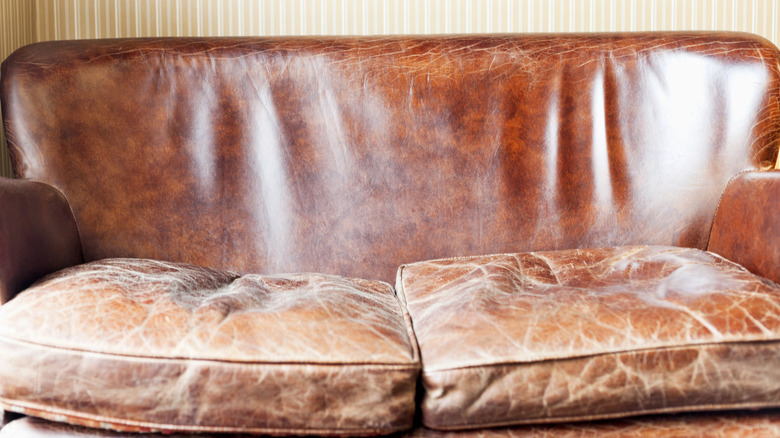Don't Toss Your Peeling Faux Leather Couch — Here's How Paint Can Revamp It
The beauty of leather is that it develops a natural patina -– but that can also be its fatal flaw. If you have a leather couch that has seemingly reached the end of its life, don't give up just yet. Although you can keep your leather furniture soft and supple with natural glycerin, there are other clever ways to revive the peeling surface. All you need to do is clean, prep, and paint the old leather sofa. Start by cleaning the surface of your sofa with a dry cloth followed by a damp cloth, then apply a dedicated leather cleaner. Don't forget to avoid these common mistakes when cleaning your leather furniture.
Remove the old bits of leather to prepare your sofa for priming and painting. You can peel away large pieces of loose leather or use the Heirloom Traditions Bond-N-Flex Vinyl & Leather Repair to spread over deep tears and scratches. Verify whether your sofa is made from real or faux leather. Acrylic paint can be fickle with faux leather if it's made of vinyl, so a primer can help prevent potential plasticizer migration. You can use a product specifically intended for faux leather or the Angelus Leather Preparer and Deglazer for real leather to create a barrier before applying the paint. Each product is different, so make sure to follow the manufacturer's instructions regarding the number of coats and how long the primer needs to dry. If you have a real leather sofa, it is possible to apply the acrylic paint directly, but it's still best to use a primer.
How to apply paint when revamping your leather sofa
Before you start the revamping process, check out our tips to know before painting a leather sofa. It's recommended to paint in three thin layers, rather than relying on a single coat. While you must always follow the manufacturer's instructions on your selected paint, you may need to let each layer dry for 24 hours. If you want to create a textured, slightly aged appearance, use a cloth to dab the leather while the paint is still wet. Ensure your space is well-ventilated as you let the paint dry.
If you have crevices or seams in your cushions, you can decide whether to use a small brush to coat them completely or simply brush over them lightly for a more rustic look. Alternatively, you can also concentrate the paint more heavily on areas like seams and tufted buttons for a burnished appearance. You'll also need to decide whether you prefer a matte or glossy finish on your couch. Acrylic finishes are available in all kinds, from no-shine to high-gloss finishes –- it all depends on the look you're trying to achieve.
